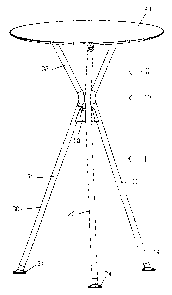Some of the information on this Web page has been provided by external sources. The Government of Canada is not responsible for the accuracy, reliability or currency of the information supplied by external sources. Users wishing to rely upon this information should consult directly with the source of the information. Content provided by external sources is not subject to official languages, privacy and accessibility requirements.
Any discrepancies in the text and image of the Claims and Abstract are due to differing posting times. Text of the Claims and Abstract are posted:
| (12) Patent Application: | (11) CA 2606209 |
|---|---|
| (54) English Title: | FOLDING TABLE |
| (54) French Title: | TABLE PLIANTE |
| Status: | Deemed Abandoned and Beyond the Period of Reinstatement - Pending Response to Notice of Disregarded Communication |
| (51) International Patent Classification (IPC): |
|
|---|---|
| (72) Inventors : |
|
| (73) Owners : |
|
| (71) Applicants : |
|
| (74) Agent: | MARKS & CLERK |
| (74) Associate agent: | |
| (45) Issued: | |
| (22) Filed Date: | 2007-10-09 |
| (41) Open to Public Inspection: | 2008-04-23 |
| Examination requested: | 2008-08-21 |
| Availability of licence: | N/A |
| Dedicated to the Public: | N/A |
| (25) Language of filing: | English |
| Patent Cooperation Treaty (PCT): | No |
|---|
| (30) Application Priority Data: | ||||||
|---|---|---|---|---|---|---|
|
For a table with three legs (10, 20, 30) and a table surface (40) which folds
down, said
table also standing on its three legs when the table surface is folded down,
and the legs
run together toward the table surface in a lower region (I), the invention
specifies that
the legs diverge at a slant from each other toward the table surface in an
upper region
(II), two of the three legs (10, 20) are joined to the table surface by
tilting linkages and
the third leg (30) is composed of a lower (31) and an upper part (32), while
the upper
part (32) comprises the upper region of the third leg, is detachably joined to
the table
surface, and can turn relative to the lower part.
Note: Claims are shown in the official language in which they were submitted.
Note: Descriptions are shown in the official language in which they were submitted.

2024-08-01:As part of the Next Generation Patents (NGP) transition, the Canadian Patents Database (CPD) now contains a more detailed Event History, which replicates the Event Log of our new back-office solution.
Please note that "Inactive:" events refers to events no longer in use in our new back-office solution.
For a clearer understanding of the status of the application/patent presented on this page, the site Disclaimer , as well as the definitions for Patent , Event History , Maintenance Fee and Payment History should be consulted.
| Description | Date |
|---|---|
| Time Limit for Reversal Expired | 2011-10-11 |
| Application Not Reinstated by Deadline | 2011-10-11 |
| Deemed Abandoned - Conditions for Grant Determined Not Compliant | 2010-10-13 |
| Deemed Abandoned - Failure to Respond to Maintenance Fee Notice | 2010-10-12 |
| Notice of Allowance is Issued | 2010-04-13 |
| Letter Sent | 2010-04-13 |
| Notice of Allowance is Issued | 2010-04-13 |
| Inactive: Filing certificate - RFE (English) | 2010-04-09 |
| Inactive: Approved for allowance (AFA) | 2010-03-16 |
| Inactive: Applicant deleted | 2009-08-10 |
| Amendment Received - Voluntary Amendment | 2009-07-23 |
| Letter Sent | 2008-10-20 |
| Request for Examination Requirements Determined Compliant | 2008-08-21 |
| All Requirements for Examination Determined Compliant | 2008-08-21 |
| Request for Examination Received | 2008-08-21 |
| Application Published (Open to Public Inspection) | 2008-04-23 |
| Inactive: Cover page published | 2008-04-22 |
| Correct Applicant Request Received | 2008-03-17 |
| Inactive: First IPC assigned | 2008-02-05 |
| Inactive: IPC assigned | 2008-02-05 |
| Inactive: Filing certificate - No RFE (English) | 2007-11-23 |
| Filing Requirements Determined Compliant | 2007-11-23 |
| Letter Sent | 2007-11-23 |
| Application Received - Regular National | 2007-11-19 |
| Abandonment Date | Reason | Reinstatement Date |
|---|---|---|
| 2010-10-13 | ||
| 2010-10-12 |
The last payment was received on 2009-10-07
Note : If the full payment has not been received on or before the date indicated, a further fee may be required which may be one of the following
Please refer to the CIPO Patent Fees web page to see all current fee amounts.
| Fee Type | Anniversary Year | Due Date | Paid Date |
|---|---|---|---|
| Application fee - standard | 2007-10-09 | ||
| Request for examination - standard | 2008-08-21 | ||
| MF (application, 2nd anniv.) - standard | 02 | 2009-10-09 | 2009-10-07 |
Note: Records showing the ownership history in alphabetical order.
| Current Owners on Record |
|---|
| SEDUS STOLL AKTIENGESELLSCHAFT |
| Past Owners on Record |
|---|
| SIEGFRIED DONNER |
| TOBIAS WEISSENRIEDER |